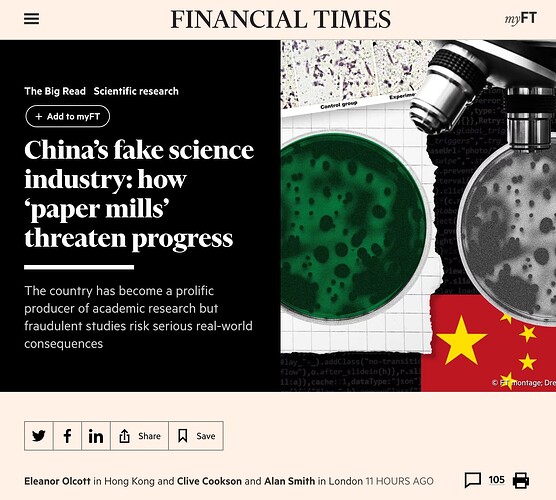-
约翰-切斯布罗(John Chesebro)在生物医学出版商斯潘迪多斯(Spandidos)担任欺诈检测员,他在那里寻找研究论文中接近相同的细胞图像。
-
造纸厂为了捏造科学研究而使用的伎俩,从明显的重复到更微妙的操纵。
-
切斯布罗估计,他拒绝了5-10%的论文,因为有欺诈性数据或道德问题。
-
Spandidos的总部设在雅典和伦敦,其大部分产出来自中国作者。
-
在2010年代中期,该出版社被指控发表了使用回收数据的论文,因此它创建了一个内部欺诈探测器团队,以剔除和撤回虚假研究。
-
在过去20年里,中国已经成为世界上最多产的科学论文出版国之一。
-
2021年,中国产生了370万篇论文,占全球产量的23%,仅次于美国的440万篇。
-
2020年,中国在被引用最多的论文数量上超过了美国,尽管这部分是由于多次提到中国对Covid-19病毒基因组的研究。
-
中国正在与美国竞争,以成为全球研究量的领导者。
-
中国在量子技术、基因组学和空间科学等领域的进步已经引起了西方国家首都的关注。
-
一些大学已经开始对中国学者进行背景调查,因为担心知识产权被盗。
-
中国令人印象深刻的产出掩盖了系统性的低效率和低质量/欺诈性的研究。
-
中国学者在发表论文时感到压力,他们注重的是数量而不是质量。
-
世界上的科学出版商对欺诈的规模越来越感到震惊。
-
撤稿的情况很少,而且可能需要数年时间,导致科学家可能在假论文的基础上继续研究。
-
伯恩哈德-萨贝尔呼吁全球迅速采取行动,恢复对科学的信任。
-
信任对于科学来说是至关重要的,如果失去了信任,就很难再恢复。
-
经纪人和 "忙人 "正在独立监督中国可疑研究的产出。
-
大卫-比姆勒(David Bimler)发现吉林大学有150篇生物医学论文使用了相同的几组数据,并得出结论,该机构有一个内部造纸厂。
-
造纸厂为了盈利而产生虚假的手稿,估计虚假产出的比例在2-20%之间。
-
在中国的电子商务网站上,出售按订单写作的论文的在线经纪人层出不穷。
-
执法不力意味着科学不端行为仍然很猖獗。
-
红旗包括作者拒绝分享支持其假设的基础数据。
-
在中国,争夺有限资源的竞争规模加剧了出版压力。
-
学者在顶级期刊上发表文章可以获得现金奖励,尽管这种做法越来越被人诟病。
-
由于临床医生需要通过发表文章来提升医院的地位,医学领域在制造虚假研究方面的名声尤其不好。
-
即使是著名的科学家也被发现进行虚假的研究。
-
由于地缘政治关系的破裂和中国研究人员利用海外实验室窃取知识产权的指控,西方和中国学术机构之间的不信任一直在增长。
-
诺和诺德基金会正在对来自中国的申请人进行背景调查,以专利衡量,中国已经成为研究商业化的世界领导者。
-
西方政府为中国科技研究人员进入他们的大学设置了障碍,担心这些学术交流促成了中国在全球的迅速崛起。
-
中国资助了大量科学毕业生出境到东京、旧金山和伦敦的大学学习,并提供奖励,让他们在完成学业后返回大陆。
-
这种 "海龟 "战略促进了国际合作,提高了中国的标准,然而,随着各国减少参与,中国的研究产出前景不明。
-
受过国际培训的中国学者最有可能在领先的出版物上发表文章。
-
美国的科学倡导者们正在努力确保与中国的合作不会完全崩溃。
-
如果与西方的科学关系破裂,受影响最大的是勤奋的中国学者,因为不信任的气氛和中国在研究方面的欺诈性声誉使他们更难获得国际认可。
-
中国的研究人员可以通过开展实验帮助支持西方的研究结果,而且中国在跨越现有技术进入新领域方面是成功的。
-
John Chesebro works as a fraud detector at biomedical publisher Spandidos, where he looks for near identical images of cells in research papers.
-
The tricks used by paper mills in order to fabricate scientific studies range from clear duplication to more subtle manipulation.
-
Chesebro estimates that he rejects 5-10 percent of papers because of fraudulent data or ethical issues.
-
Spandidos is based in Athens and London, and most of its output is from Chinese authors.
-
In the mid-2010s, the publisher was accused of publishing papers with recycled data, and so it created a team of in-house fraud detectors to weed out and retract fake research.
-
China has become one of the world’s most prolific publishers of scientific papers in the past two decades.
-
In 2021, it produced 3.7mn papers, 23 percent of global output, and just behind the 4.4mn total from the US.
-
In 2020, China surpassed the US for the number of most cited papers, although this was partially due to multiple references to Chinese research on the Covid-19 virus genome.
-
China is competing with the US to become the global leader in research volume.
-
Chinese advancements in fields such as quantum technology, genomics and space science have caused concern in western capitals.
-
Some universities have started background checks on Chinese academics due to fear of intellectual property theft.
-
China’s impressive output masks systemic inefficiencies and low-quality/fraudulent research.
-
Chinese academics feel pressure to focus on quantity over quality when publishing.
-
The world’s scientific publishers are becoming increasingly alarmed by the scale of fraud.
-
Retractions are rare and can take years, leading to scientists potentially building on fake paper’s findings.
-
Bernhard Sabel is calling for swift global action to restore trust in science.
-
Trust is essential for science and if it is lost, it is hard to go back.
-
Brokers and ‘busybodies’ are independently policing China’s output of dubious research.
-
David Bimler identified 150 biomedical papers from Jilin University that used the same few data sets and concluded that the institution had an internal paper mill.
-
Paper mills generate fraudulent manuscripts for profit and estimates of fake output range from 2-20%.
-
Online brokers selling written-to-order papers proliferate on Chinese ecommerce sites.
-
Weak enforcement means scientific misconduct is still rife.
-
Red flags include authors refusing to share underlying data that supports their hypothesis.
-
Pressure to publish is exacerbated by the scale of competition fighting for limited resources in China.
-
Academics are awarded cash bonuses for publishing in top journals, although this practice is increasingly frowned upon.
-
Medical sphere has a particularly bad reputation for producing fake research due to clinicians needing to publish to climb the hospital hierarchy.
-
Even prominent scientists have been found to produce dodgy research.
